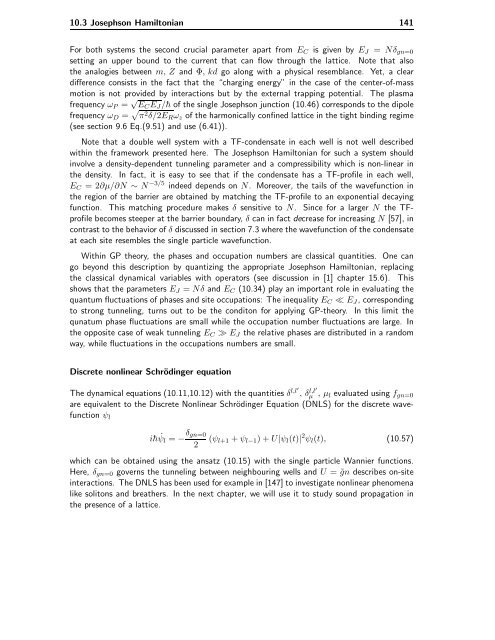Bose-Einstein Condensates in Rotating Traps and Optical ... - BEC
Bose-Einstein Condensates in Rotating Traps and Optical ... - BEC
Bose-Einstein Condensates in Rotating Traps and Optical ... - BEC
You also want an ePaper? Increase the reach of your titles
YUMPU automatically turns print PDFs into web optimized ePapers that Google loves.
10.3 Josephson Hamiltonian 141<br />
For both systems the second crucial parameter apart from EC is given by EJ = Nδgn=0<br />
sett<strong>in</strong>g an upper bound to the current that can flow through the lattice. Note that also<br />
the analogies between m, Z <strong>and</strong> Φ, kdgo along with a physical resemblance. Yet, a clear<br />
difference consists <strong>in</strong> the fact that the “charg<strong>in</strong>g energy” <strong>in</strong> the case of the center-of-mass<br />
motion is not provided by <strong>in</strong>teractions but by the external trapp<strong>in</strong>g potential. The plasma<br />
frequency ωP = √ ECEJ/¯h of the s<strong>in</strong>gle Josephson junction (10.46) corresponds to the dipole<br />
frequency ωD = π2δ/2ERωz of the harmonically conf<strong>in</strong>ed lattice <strong>in</strong> the tight b<strong>in</strong>d<strong>in</strong>g regime<br />
(see section 9.6 Eq.(9.51) <strong>and</strong> use (6.41)).<br />
Note that a double well system with a TF-condensate <strong>in</strong> each well is not well described<br />
with<strong>in</strong> the framework presented here. The Josephson Hamiltonian for such a system should<br />
<strong>in</strong>volve a density-dependent tunnel<strong>in</strong>g parameter <strong>and</strong> a compressibility which is non-l<strong>in</strong>ear <strong>in</strong><br />
the density. In fact, it is easy to see that if the condensate has a TF-profile <strong>in</strong> each well,<br />
EC =2∂µ/∂N ∼ N −3/5 <strong>in</strong>deed depends on N. Moreover, the tails of the wavefunction <strong>in</strong><br />
the region of the barrier are obta<strong>in</strong>ed by match<strong>in</strong>g the TF-profile to an exponential decay<strong>in</strong>g<br />
function. This match<strong>in</strong>g procedure makes δ sensitive to N. S<strong>in</strong>ce for a larger N the TFprofile<br />
becomes steeper at the barrier boundary, δ can <strong>in</strong> fact decrease for <strong>in</strong>creas<strong>in</strong>g N [57], <strong>in</strong><br />
contrast to the behavior of δ discussed <strong>in</strong> section 7.3 where the wavefunction of the condensate<br />
at each site resembles the s<strong>in</strong>gle particle wavefunction.<br />
With<strong>in</strong> GP theory, the phases <strong>and</strong> occupation numbers are classical quantities. One can<br />
go beyond this description by quantiz<strong>in</strong>g the appropriate Josephson Hamiltonian, replac<strong>in</strong>g<br />
the classical dynamical variables with operators (see discussion <strong>in</strong> [1] chapter 15.6). This<br />
shows that the parameters EJ = Nδ <strong>and</strong> EC (10.34) play an important role <strong>in</strong> evaluat<strong>in</strong>g the<br />
quantum fluctuations of phases <strong>and</strong> site occupations: The <strong>in</strong>equality EC ≪ EJ, correspond<strong>in</strong>g<br />
to strong tunnel<strong>in</strong>g, turns out to be the conditon for apply<strong>in</strong>g GP-theory. In this limit the<br />
qunatum phase fluctuations are small while the occupation number fluctuations are large. In<br />
the opposite case of weak tunnel<strong>in</strong>g EC ≫ EJ the relative phases are distributed <strong>in</strong> a r<strong>and</strong>om<br />
way, while fluctuations <strong>in</strong> the occupations numbers are small.<br />
Discrete nonl<strong>in</strong>ear Schröd<strong>in</strong>ger equation<br />
The dynamical equations (10.11,10.12) with the quantities δ l,l′<br />
,δ l,l′<br />
µ ,µl evaluated us<strong>in</strong>g fgn=0<br />
are equivalent to the Discrete Nonl<strong>in</strong>ear Schröd<strong>in</strong>ger Equation (DNLS) for the discrete wavefunction<br />
ψl<br />
i¯h ˙ ψl = − δgn=0<br />
2<br />
(ψl+1 + ψl−1)+U|ψl(t)| 2 ψl(t), (10.57)<br />
which can be obta<strong>in</strong>ed us<strong>in</strong>g the ansatz (10.15) with the s<strong>in</strong>gle particle Wannier functions.<br />
Here, δgn=0 governs the tunnel<strong>in</strong>g between neighbour<strong>in</strong>g wells <strong>and</strong> U =˜gn describes on-site<br />
<strong>in</strong>teractions. The DNLS has been used for example <strong>in</strong> [147] to <strong>in</strong>vestigate nonl<strong>in</strong>ear phenomena<br />
like solitons <strong>and</strong> breathers. In the next chapter, we will use it to study sound propagation <strong>in</strong><br />
the presence of a lattice.




